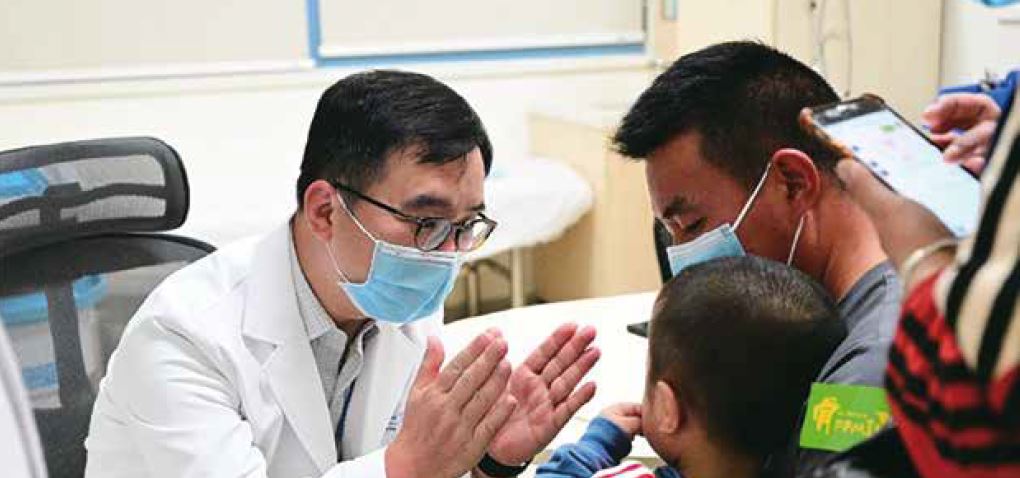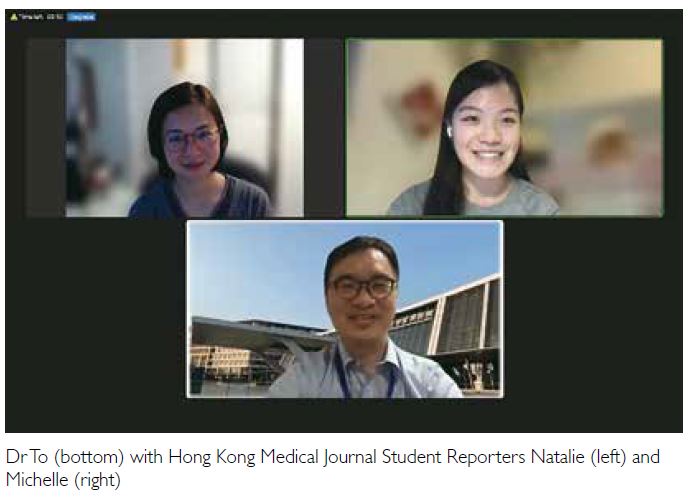© Hong Kong Academy of Medicine. CC BY-NC-ND 4.0
HEALTHCARE FOR SOCIETY
Cross-border treatment for rare bone diseases: an interview with Dr Michael Kai-tsun To
Michelle Tsui1, Natalie Cheuk2
1 MB, ChB, Department of Psychiatry, Shatin Hospital and Tai Po Hospital, Hong Kong SAR, China
2 MB, BS, Department of Psychiatry, Queen Mary Hospital, Hong Kong SAR, China
Dr Michael Kai-tsun To is a paediatric orthopaedic
surgeon and well-known expert in osteogenesis
imperfecta (OI). He received training in orthopaedics
at Queen Mary Hospital, where he now offers his
expertise; he also serves as a clinical associate
professor at The University of Hong Kong (HKU).
Since the establishment of the HKU-Shenzhen
Hospital in 2012, Dr To has travelled between Queen
Mary Hospital and Shenzhen to provide cross-border
care for children with bone diseases. Dr To’s
dedication to children with rare bone diseases was
recognised in 2018 when he received the Hong Kong
Humanity Award.
One of Dr To’s most important projects has
been the establishment of a rare bone disease centre
in Shenzhen, where he provides medical expertise to
families from multiple provinces in China. Although
it is now a full-fledged specialist service centre, it
originated from rather humble beginnings.
Osteogenesis imperfecta is a rare, heritable
brittle bone disease with a prevalence of 1 in 10 000.
Patients with this disease may exhibit deformities
and can easily develop fractures. Although treatment
is available, it is prohibitively expensive; because OI
is rare, specialists with relevant expertise are often
difficult to find. Although relatively few patients
with OI attend the Duchess of Kent Children’s
Hospital (DKCH) in Hong Kong, one such patient contributed to
the establishment of the OI service now thriving in
Shenzhen.
Around 2012, while working at the HKU-Shenzhen Hospital, Dr To provided follow-up care for an adult patient with OI. Many years prior,
when Dr To was still a medical student, the doctors
at DKCH had performed complex
surgical treatment of OI in this patient. The patient
had presented to DKCH with difficulty walking;
after surgery, he regained the ability to walk and
subsequently moved to Guangzhou. The grateful
patient asked if the new hospital could help other
patients with OI as he had been helped in childhood.
Through this patient and various WeChat patient
groups, numerous families caring for children with
OI found their way to the HKU-Shenzhen Hospital.
The rare bone disease centre expanded
organically in response to the overwhelming
demand. Since then, the centre has gained sufficient
recognition that it has been the site of more than
1000 surgical treatments for children with rare bone
diseases. When asked how he came to devote much
of his career to caring for these children, Dr To
jokingly quoted a Hong Kong action movie “Shock Wave”, in which
an explosive ordnance disposal specialist (portrayed
by Andy Lau) explained that he did not enter into the
profession by choice—it was a matter of fate.
Today, the centre is well-known throughout
Mainland China for its expert management of OI.
The journey from its beginnings in the early 2010s to its
present success has been filled with challenges. In
particular, substantial time and effort were needed
to establish patient trust in a treatment that was
relatively unknown. Initially, there were rumours in
patient WeChat groups that Dr To was a 'liar' for
claiming that surgery can potentially restore mobility in patients with OI. However, the increasing number
of patient success stories gradually outweighed the
distrust and doubts.
As the service expanded and demand grew, Dr
To travelled from Pokfulam to Shenzhen each day
before 7 am, returning across the border at 6 pm.
Cross-border travel became more difficult during
the early portion of the coronavirus disease 2019
pandemic because of lengthy quarantine mandates.
To address this situation, Dr To sacrificed time
with his family and coordinated with colleagues to
ensure that clinical services in Hong Kong continued
smoothly in his absence.
Through the OI centre in Shenzhen, Dr
To gained knowledge of the unique challenges
encountered by patients with OI in Mainland
China. Many patients travelled great distances and
incurred substantial financial burdens to reach the
HKU-Shenzhen Hospital. In one memorable case,
a mother with OI (and height of <1 m) and her
son with OI travelled for 40 hours to reach the OI
centre. Recognising the great need for medical care
outside of major cities, Dr To led service trips across
the country, including visits to Yunnan, Sichuan
and Tibet, to provide medical care and train local
medical professionals. Local residents often eagerly
waited for the medical team’s arrival, and they offered
unexpected tokens of gratitude to the doctors.
Dr To recalled that one patient brought a freshly
slaughtered chicken to his clinic! He also recalled
the story of a 17-year-old boy with OI in Sichuan,
who complained of tongue pain refractory to high
doses of analgesics. He had not received a proper
diagnosis, despite multiple specialist consultations.
Upon arrival, Dr To’s team promptly made the
diagnosis of basilar invagination as a complication of
OI, then obtained funding to help finance the boy’s
treatment. After regaining full use of his tongue, the
boy greeted everyone by proudly sticking his tongue
out.
In addition to providing unforgettable anecdotes, the sincere gratitude from patients
during these service trips encouraged Dr To and his
team to continue their cross-border efforts. In 2020,
Dr To and his team received a special research grant
from the Chinese government to support their OI
clinical service and research—it was a well-deserved
moment of recognition for sustained effort over the
past decade.
The OI service in Shenzhen has also delivered
unexpected gains in Hong Kong. Because of the
high patient volume in Shenzhen, the HKU team
has become internationally renowned, leading to
multiple research and training opportunities. At the
time of writing, Dr To and his team are preparing
to host the 2025 OI conference in Hong Kong—the
first OI conference outside of Europe and North
America. This great honour is expected to inspire
further developments in OI research and treatment
in Hong Kong.

Figure 1. Dr To examining a child during the 2022 Wishbone Day at The University of Hong Kong–Shenzhen Hospital

Figure 2. Dr To (bottom) with Hong Kong Medical Journal Student Reporters Natalie (left) and Michelle (right)

